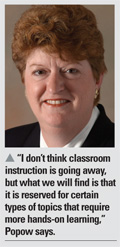The 80/20 rule is a common saying in insurance. It refers to thetheory that about 20 percent of insureds generate 80 percent ofclaims. When dealing with too many “worst case scenarios,” however,claims professionals can develop a myopic view of insureds. This iswhere formal and hands-on learning come into play. Donna J. Popow, Esq., CPCU, AIC, explains how education helpscultivate a better understanding of claims handling and thebusiness overall. She also says that striking a balance betweenhecticworkloads and professional development is easier than one might think.
| Claims professionals often report being overworked. Howattainable is education and specialized training in this pressurecooker environment?
Claims professionals often report being overworked. Howattainable is education and specialized training in this pressurecooker environment?
I started in claims in 1977 and I don't think a year went by thatwe weren't complaining of being overworked. Having said that, I dothink the change in the way claims are handled has put an increasedburden on file handlers in terms of file documentation andadditional reporting and data entry work. So I can empathize withoverworked claims personnel and acknowledge that companies aredoing more with less. It is always debatable as to whether claimsorganizations have ample resources.
There is no doubt that they're busy. Claims professionals haveto make a decision about continuing education, whether that means license requirements,requirements of the job, or their own professional development.
|So you are saying that development falls intoessentially three distinct groups?
Yes. It's common for insurers to build in a professionaldevelopment plan in an employee's performance review. The bottomline is that if you have any ambition in making insurance a career,you are going to have to find the time to do this so hopefully youand your employer can come to an agreement as to when that timewill be reserved. For instance, you may need to find a way to carveout two hours of study time with the employer giving the studentone hour from work and the student giving up one hour of free time,say at lunch.
Why is the need for development arguably morepronounced in our profession?
Claims professionals have to keep learning because the environment is constantly changing. Caselaw and building standards must evolve, and those affect how weinterpret the terms of each policy and then apply coverage. Forexample, consider 'greenconstruction.' That represents a whole different line ofthinking when replacing portions of a structure or rebuilding.
Does formal education offer a professional advantagecompared to hands-on field training?
I think that there is a need—and also time—for both types oftraining. A claims professional must be a “jackof all trades.” Informal training could mean having lunch witha law firm to learn about case law developments that will help youdo your job better. With that said, if you have any ambition forupward movement in your company, then formalized education is amust.
Specialized or more formal training equips youwith expanded business acumen. By their nature, claims people tendto focus entirely on the claims world. However, you will get abroader view of the industry through education. In turn, this makesyou a more valuable employee. A formal program, assuming that youhave picked an area in which you are either currently involved orshould be, will increase your technical competency.
|Formal education for any insurance professional will positionthat individual and, by extension, the employer to be morecompetitive. If an independent adjusting firm can say that 95percent of their staff have an associate in claims designation fromthe Institutes, then that is a clear metric. An employer can pointto this, and their clients should see that those people are makinga concerted effort to stay on top of things. Also, education givesyou a better understanding of global issues that impact insuranceboth today and in the future. Continuing education is clearly ahigh-value proposition.
|How might all of this play out in the hiringprocess?
It may be difficult to initially evaluate knowledge gained in thefield. People falsify resumes all the time. In my personalexperience, the certification or designation is often the tiebreaker between equally qualified individuals. So if an insurer isevaluating two candidates that are equally qualified in terms ofexperience, that certification or designation may be just enough to tip thescales in one's favor.
Are there modes that facilitate learning forMillennials specifically?
There has been a lot of talk about Millennials. The bottom line isthis: today's workers, regardless of the age group, only have alimited amount of time to devote to education, and so education providers must listen to what those people aretelling them. For example, claims folks always say they want highlyportable material. So we have gone to more online presentation andeven there we are packaging it in smaller more digestible chunks sothat an adjuster stuck in an airport with a 45-minute delay mightbe able to go through one module during that time period. That isthe beauty of online content. It is reacting to what customers tellus they want.
These days, training is geared to how people actually work andhow they find the time to pursue professional growth. At TheInstitutes, courses are typically oriented toward laptop anddesktop learning. Our online courses are Flash-based and will runon devices that support Flash. We put the information into moremanageable units. If that employee says he or she can only manageone hour, then I know he or she can complete a specific moduleduring that time. We have a mobile app for our SMART onlinepractice exams. We offer SMART QuizMe Review apps for each of ourCPCU courses—500, 520, 530, 540, 551, 552, 553, 555, and 557.Versions are available for purchase for use on both iPhone andAndroid.
|Is classroom training going the way of thedinosaur?
I don't think classroom instruction is going away but what we willfind is that it is reserved for certain types of topics thatrequire more hands-on learning. You can learn a lot online but whenyou are standing in a burned building with a tape measure, it is abit different.
There is value in learning in a mockup of a damaged vehicle orhouse. Similarly, negotiation simulations are great for practicebut you still need to get in there face-to-face, to read bodylanguage, watch eye movement and become attuned to the dynamics. Inthe high-end complex world of negotiation, this practice is ofextraordinarily high value. There is a reason why we still havejury consultants and do mock trials in front of sample juries.
|Also, when you look at attendance at conferences, there is stilldemand for classroom. Some content is more effectively delivered ina classroom setting. At the very least, this setting provides anopportunity to talk with others and get feedback.
Want to continue reading?
Become a Free PropertyCasualty360 Digital Reader
Your access to unlimited PropertyCasualty360 content isn’t changing.
Once you are an ALM digital member, you’ll receive:
- All PropertyCasualty360.com news coverage, best practices, and in-depth analysis.
- Educational webcasts, resources from industry leaders, and informative newsletters.
- Other award-winning websites including BenefitsPRO.com and ThinkAdvisor.com.
Already have an account? Sign In
© 2024 ALM Global, LLC, All Rights Reserved. Request academic re-use from www.copyright.com. All other uses, submit a request to [email protected]. For more information visit Asset & Logo Licensing.








